
|
Sale 20
Pre-Long Beach Coin Auction
| Lot |
Photo |
Description |
Realized |
Lot 111 |
 |
Great Britain. Noble, Nd. Fr-89; SC-15. Edward III, 1327-1377. Fourth Coinage. Pre-Treaty period, with French titile. Ruler in ship. Reverse: Ornamental cross. Extremely Fine.
Estimated Value $1,250 - 1,750.
Not part of the Terner Collection.
View details and enlarged photos
| Realized
$2,070 |
Lot 112 |
 |
Great Britain. Noble, Nd. Fr-100. Richard II, 1377-1399. Ruler in ship. Reverse: Ornamental cross. Some blundering in the lettering. Nearly Extremely Fine.
Estimated Value $1,250 - 1,750.
Not part of the Terner Collection.
View details and enlarged photos
| Realized
$2,415 |
Lot 113 |
 |
Great Britain. Noble, Nd. Fr-109. Henry V, 1413-1422. Cross pattee. Ruler in ship. Reverse: Ornamental cross. Boldly struck example. Extremely Fine to About Uncirculated.
Estimated Value $1,500 - 2,000.
Not part of the Terner Collection.
View details and enlarged photos
| Realized
$2,990 |
Lot 114 |
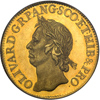 |
Great Britain. Pattern Broad, 1656. By Thomas Simon. Oliver Cromwell. Reeded edge. WR-39. S-3225; Fr-273. The so-called gold Broad, valued in 1656 at 20 shillings, was in effect the very first Guinea, which was invented in the following decade and also valued at 20 shillings. In earlier, hammered versions, it was known as the Pound. Cromwell's golden Broad brought back a tradition lost for some decades, that of placing the monarch's portrait on the "face" of the coin. Cromwell, however, famously declined the regal title, opting for Lord Protector in its stead. But in reality, Oliver Cromwell ruled with great personal authority and influence, much as had the long succession of monarchs before him. His Broad is considered very rare (R2 in Wilson & Rasmussen), but the R2 rating does an injustice to this particular specimen, in that most of these pieces, when seen, are heavily impaired by scratches, digs, cleaning, and other abuse. This sharp piece is an appealing cameo Proof with excellent surfaces and superior eye-appeal. In fact, in 22 years of looking at fine English gold coins, this is the best one seen. PCGS graded Proof 63 Cameo.
Estimated Value $10,000 - 15,000.
View details and enlarged photos
| Realized
$43,700 |
Lot 115 |
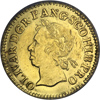 |
Great Britain. Half Broad, 1658. By Johann Sigismund Tanner. Oliver Cromwell. WR-41. Grained edge. This is the rarest of all Cromwell's gold coins, struck by Tanner in 1738 for collectors. No contemporary half broad was ever coined. The classic reference Numismata Cromwelliana, by Henry William Henfrey (London, 1877), notes that Tanner used Thomas Simon's 1650s punches for the portrait as well as the crowned shield of arms, which Simon had used for the sixpence coins (both still preserved in the Royal Mint die-collection), but invented the various other devices; it was because of such invention that the legends differ slightly from those of the coins struck during Cromwell's lifetime. The grained edge variety is R7: exceedingly rare, and obviously this specimen easily fits among the finest known. Henfrey knew of only 3 pieces made with the grained edge, citing such owners as the Bodleian Library at Oxford University. The half broad was so famously rare, even in the 19th century, that Henfrey had to examine such impounded coins as those owned by the Hermitage and British museums. PCGS graded MS-63.
Estimated Value $12,000 - 15,000.
This marvelous coin is ex Montague, Maynard, Murdoch, and Brand.
View details and enlarged photos
| Realized
$20,125 |
Lot 116 |
 |
Great Britain. Pattern Broad, or Guinea, 1662. By Thomas Simon. Charles II, Laureate and Draped Bust facing left. The "FLORENT CONCORDIA REGNA" legend surrounds a square shield on the reverse, with date above. Plain edge. Not listed by Wilson & Rasmussen, but actually one of the few suggested designs for England's first golden Guinea. North-2780; KM-Pn32: rare. Virtually as struck, lovely portrait and highly lustrous obverse; struck from a concave reverse die, producing somewhat "diminished" luster. Of several seen over 22 years, this was the finest. PCGS graded AU-58.
Estimated Value $4,000 - 6,000.
View details and enlarged photos
| Realized
$8,338 |
Lot 117 |
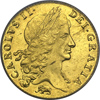 |
Great Britain. Guinea, 1664. Charles II, 2nd Laureate Bust. Elephant hallmark below bust. S-3341; Fr-288; KM-423.2, cited by Spink as extremely rare, and one of the few coins in that reference listed but unpriced. In fact, when this piece was purchased at auction in 1992, no reference we could locate had ever listed a value, in any condition. This is a famed specimen, too: ex Bridgewater House sale, lot 143. Despite some faint tin impurities in the flan (typical of this era), this coin is as struck with gorgeous eye-appeal and a remarkably bold strike for its time. Evidently it was made for some special purpose, and subsequently saved with great care. It glows with a luster found on very few other gold coins of the 1660s. It is one of the rarest and most important coins in the Terner Collection, a centerpiece of such stature that even a VF piece, could one be found, would fetch five figures. Its stature derives from this: the Guinea denomination was named for the original source of British gold ore in the mid-17th century, from the country in Africa then called Guinea; and this particular coin, as the first gold piece of this size to bear the distinctive Elephant hallmark, is thus the prototype for all guineas to come. Doubtless the finest known. A coin of such importance that its equivalent, in U.S. gold coins, would have to be the 1822 half eagle or the 1849 prototype double eagle. Most simply put, it is "the rarest of the rare" among historical English gold coins. PCGS graded MS-64.
Estimated Value $35,000 - 45,000.
View details and enlarged photos
| Realized
$48,300 |
Lot 118 |
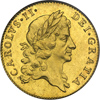 |
Great Britain. Guinea, 1665. Charles II, 3rd laureate Bust. S-3342; Fr-287; KM-424.1. This wonderful and very special coin should be listed in the Wilson & Rasmussen Proofs book, for it is clearly out of the ordinary. We believe it is a Specimen strike, but unrecorded. Not only is this a very rare date, virtually unavailable even in nice EF, but it's also one of the finest known Charles II guineas of any style. Extremely rare, prooflike and of remarkable quality! Privately purchased in 1989 from Spink for a multiple of catalogue value. PCGS graded Specimen 63.
Estimated Value $10,000 - 15,000.
View details and enlarged photos
| Realized
$23,000 |
Lot 119 |
 |
Great Britain. Guinea, 1666. Charles II, 3rd laureate Bust. S-3342; Fr-287; KM-424.1. Struck at the time of the Great Plague and the devastating Fire of London, therefore probably made in very small numbers. Patches of die rust appear under "66 MAG." Unusually pretty, obviously most desirable and very rare in this state. Sharply struck except for the very center of the reverse and on the lock over the king's ear. While this 1666 guinea is a great coin, comparing it to the 1665 guinea above also demonstrates that coin's special Specimen qualities. PCGS graded AU-58.
Estimated Value $5,000 - 7,000.
View details and enlarged photos
| Realized
$10,350 |
Lot 120 |
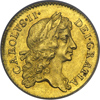 |
Great Britain. Half Guinea, 1669. Charles II, 1st Bust. S-3347; Fr-290; KM-431. The first year of issue for the then-new half guinea, the first milled-gold coin of this size struck in England. This style, with the pointed truncation of the king, was used only for four years and is most artistic. This excellent specimen possesses lovely, fresh surfaces but exhibits typical slight weakness of strike in the king's hair and on the French crest. Very rare grade! PCGS graded MS-63.
Estimated Value $6,000 - 8,000.
Ex Bridgewater House Collection.
View details and enlarged photos
| Unsold |
Lot 121 |
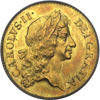 |
Great Britain. Half Guinea, 1670. Charles II, 1st Bust. S-3347; Fr-290; KM-431. The best half guinea of this king encountered in 22 years of collecting. Extremely rare so fine, probably the finest known. PCGS graded MS-62.
Estimated Value $5,000 - 7,000.
Ex Norweb Collection.
View details and enlarged photos
| Realized
$8,050 |
Lot 122 |
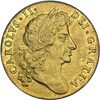 |
Great Britain. Guinea, 1674. Chares II, 4th laureate Bust. S-3344; Fr-287; KM-440.1. One of the nicest pieces of this later portraiture style encountered in 22 years. While not perfect, it's quite exceptional, and it resided previously in the private Sharps-Pixley bank collection, until 1989. PCGS graded AU-58.
Estimated Value $2,500 - 3,500.
View details and enlarged photos
| Realized
$5,750 |
Lot 123 |
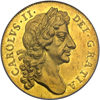 |
Great Britain. Two Guineas, 1676. Charles II, 2nd laureate Bust with rounded truncation. S-3335; Fr-284; KM-443.1. Here is possibly the finest known gold coin of Charles II, of any date or denomination. In fact, this is a world-famous specimen, last sold 14 years ago in an important London auction of English gold coins - this being the star piece of the sale. It is some sort of Prooflike or Specimen issue, as nothing else like it is known of this date or this denomination. It possesses mirrored surfaces and glorious bright luster, and both sides are deeply impressed by the dies, so that every detail of the design is clear; it is not unreasonable to suggest that it was possibly prepared for royal inspection. No one seems to know how it came to exist, but once you've seen it, you will never forget it, nor will you ever be completely satisfied with any other Double Guinea of this monarch. It might well be said that no finer portrait exists of Charles II, in any form - painted, sculpted or metallic. This coin is a treasure of the English Restoration! PCGS graded Specimen 63.
Historical note: Born in 1630 at St James Palace, and happy in his early years, Charles led a mostly secretive or secluded life during much of his father's reign, a time of warring political factions, rather than of warring nations, in which the quarry was power itself. This was England's civil war, in which monarchy in its old sense was torn apart. The prince spent his teenage years protected at the court of Louis XIV, France's "sun king," after Cromwell's army pursued his father from fortress to fortress, finally capturing, trying and executing King Charles I in January 1649 by beheading. At Paris the young prince witnessed firsthand France's blooming new culture of high art. But London became a dire place to be, ruled by the Puritans and their Lord Protector, Oliver Cromwell, until his painful 1658 death in bed from kidney stones and related ailments. Came a time, then, of Restoration of the Monarchy, in which the exiled prince was proclaimed King in 1660, regrouped his Stuart allies, showed remarkable clemency for many former traitors to the Crown, and relinquished the essence of kingship to parliamentary procedure. Charles II showed other gifts, however, bringing a new era of culture to Britain, but also one of war abroad and homeland disasters: the plague of 1665 followed by the great London fire of 1666. The diarist Pepys recorded the new political climate, and the coffehouse became a sensation of the first generation of newspaper readers. Charles built the foundations of today's national collection of artworks, loved yachting, played at the new sciences, and dallied with infamous femmes. In numismatics, too, the king's sense of beauty prevailed, as during his monarchy the brand-new Milled Coinage began, machine-made coins of great precision and careful workmanship, and a new uniformity. By the time the king died, without blood successor, in 1685, his money had been transformed into a thing of beauty and consistent value. Among the new coinage was a series of Guineas, fractions and multiples, that were nothing but the highest statement of numismatic artistry of the era. This new name was taken from the area also known as the "Gold Coast," where the Africa Company mined golden wealth for an expanding peoples who would soon reach for empire. During this reign, power was restored to royal hands, but the nation had been transformed forever from a medieval state to a more unified citizenry which cherished the pleasures of civilization, gained freedoms previously reserved for the few, and stood on the brink of becoming a military and industrial power of worldwide scope, In it all, Charles "the Merry Monarch" left the stamp of his character. To us he bequeathed such relics of his times as this monentous Double Guinea bearing his lifelike portrait, to be savored forever. No finer portrait of his exists in any form, painted, metallic or sculpted.
Estimated Value $50,000 - 60,000.
Ex Sharps-Pixley Collection.
View details and enlarged photos
| Realized
$64,400 |
Lot 124 |
 |
Great Britain. Guinea, 1676. Elephant & Castle hallmark. Charles II, 4th laureate Bust. S-3345; Fr-289; KM-440.2. Well struck and highly lustrous with delightful fields but some minor black tin flecks ("haymarks") on the reverse, which are typical of the era. Very rare so fine! An important coin. PCGS graded MS-61.
Estimated Value $4,000 - 6,000.
View details and enlarged photos
| Realized
$11,213 |
Lot 125 |
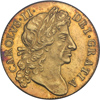 |
Great Britain. Guinea, 1678. Charles II, 4th laureate Bust. S-3344; Fr-287; KM-440.1. Rare in all grades, but especially rare in this exalted state! Glows with mint luster, has lovely fields and is generally sharp in strike (the king's hair is not quite fully detailed). A truly splendid coin, and in a very rare grade! Virtually impossible to duplicate in this condition. PCGS graded MS-63.
Estimated Value $5,000 - 7,500.
View details and enlarged photos
| Realized
$13,800 |
Lot 126 |
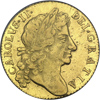 |
Great Britain. Guinea, 1680. Charles II, 4th laureate Bust. S-3345; Fr-287; KM-440.1. Prooflike, with a "soft" portrait as almost always seen on this bust type. As a testament to the outstanding early guineas in the Terner Collection, it might be pointed out that, during 22 years of diligent searching for these coins, only 7 dates were ever located (from 42 possible date varieties) that were deemed good enough to fit into this collection. Each coin was selected for its freshness of appearance, its degree of luster, and its overall quality. Quite obviously, therefore, the rarity of the first guineas in top grades remains under-appreciated. PCGS graded MS-62.
Estimated Value $3,000 - 4,000.
View details and enlarged photos
| Realized
$6,325 |
Lot 127 |
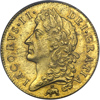 |
Great Britain. Guinea, 1685. Elephant & Castle hallmark. James II, 1st Bust. S-3401; Fr-296; KM-459.2. Extremely rare as a type, and particularly so in such a stunning condition as represented by this famous specimen. Mint fresh and beautiful! PCGS graded MS-63.
Estimated Value $7,500 - 10,000.
Ex Bridgewater House Collection.
View details and enlarged photos
| Realized
$18,400 |
Lot 128 |
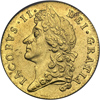 |
Great Britain. Guinea, 1686. James II, 2nd Bust. S-3402; Fr-295; KM-459.2. Unusually bold in strike on the all-important portrait of the king, lustrous and quite choice. Lovely old-time gold toning. Very rare in this state. PCGS graded AU-58.
Estimated Value $2,500 - 3,500.
View details and enlarged photos
| Realized
$3,680 |
Lot 129 |
 |
Great Britain. Guinea, 1687. James II, 2nd Bust. S-3402; Fr-295; KM-459.1. Another particularly nice example, in a very rare grade. Not perfect, but the best one located in 22 years. Purchased in 1985 and a better one was never seen thereafter. PCGS graded MS-62.
Estimated Value $3,000 - 4,000.
View details and enlarged photos
| Realized
$6,613 |
Lot 130 |
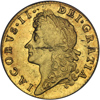 |
Great Britain. Half Guinea, 1688. James II. S-3404; Fr-297; KM-458.1. Only one portrait style was issued for this monarch, and half guineas were coined for only 3 years, gold being a most precious metal at the time. This piece is somewhat prooflike, with fresh luster but the usual softness in the strike. Very rare, especially in this grade. In 22 years of searching, we never located either of the other dates in a grade that was acceptable for inclusion in this collection. PCGS graded MS-63.
Estimated Value $4,000 - 5,000.
View details and enlarged photos
| Unsold |
Lot 131 |
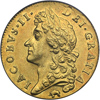 |
Great Britain. Guinea, 1688. Elephant & Castle hallmark. James II, 2nd Bust. S-3403; Fr-296; KM-459.2. Very rare! Boldly struck but showing a number of really tiny bagmarks on the reverse field; nonetheless, highly lustrous, good-looking, and the best one we could ever locate! An important coin with this highly desirable hallmark beneath the king's bust. PCGS graded AU-58.
Estimated Value $4,000 - 5,000.
View details and enlarged photos
| Realized
$6,038 |
Lot 132 |
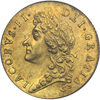 |
Great Britain. Guinea, 1688. James II, 2nd Bust. S-3402; Fr-295; KM-459.1. A small tin streak shows on the reverse, entirely typical of gold of this era (many pieces have very heavy streaks and haymarking). Lovely and rare! The final year of issue for this short-lived monarchial coinage. PCGS graded MS-61.
Estimated Value $3,000 - 4,000.
View details and enlarged photos
| Realized
$5,750 |
Lot 133 |
 |
Great Britain. Guinea, 1689. William & Mary, conjoined busts. S-3426; Fr-303; KM-474.1. A rare type in very rare grade. Superb eye-appeal, bold strike, gleaming luster. You can't ask for much more in one of these! PCGS graded MS-61.
Estimated Value $4,000 - 6,000.
View details and enlarged photos
| Realized
$10,925 |
Lot 134 |
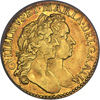 |
Great Britain. Half Guinea, 1689. William & Mary. 1st conjoined Busts. S-3429; Fr-306; KM-473. This variety was coined only in 1689. A choice coin with lovely old-time golden red toning, a few areas of weak strike as always, and the die-flaw through the king's jaw. A very rare coin - rarer in this grade than the large 5 guineas piece. PCGS graded AU-58.
Estimated Value $3,000 - 4,000.
View details and enlarged photos
| Unsold |
Lot 135 |
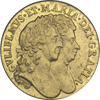 |
Great Britain. Guinea, 1690. William & Mary, conjoined busts. S-3426; Fr-303; KM-474.1. Rarer date than the last. A variant not noted in Spink, with an "F" in the king's name erroneously in place of the "E". This is a splendid semi-prooflike specimen, boldly struck. Surely among the finest known! PCGS graded AU-58.
Estimated Value $4,000 - 5,000.
View details and enlarged photos
| Realized
$7,475 |
Lot 136 |
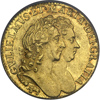 |
Great Britain. Half Guinea, 1692. William & Mary. S-3431; Fr-308; KM-476.2. 2nd conjoined Busts with Elephant and Castle hallmark; 2nd shield of arms style. Very rare, this type being coined only in 1691 and 1692. A particularly choice piece having a bold strike and exhibiting fresh luster. PCGS graded MS-62.
Estimated Value $4,000 - 6,000.
View details and enlarged photos
| Realized
$8,050 |
Lot 137 |
 |
Great Britain. Guinea, 1692. William & Mary, conjoined busts. S-3426; Fr-303; KM-474.1. The rarest date of the six years of mintage of this type. Lustrous and pleasing. PCGS graded AU-58.
Estimated Value $3,000 - 3,500.
View details and enlarged photos
| Realized
$7,763 |
Lot 138 |
 |
Great Britain. Guinea, 1693. William & Mary, conjoined busts. S-3426; Fr-303; KM-474.2. Another boldly struck, gleaming specimen; incredibly nice and very rare so splendid! PCGS graded MS-62.
Estimated Value $5,000 - 6,000.
View details and enlarged photos
| Realized
$13,225 |
Lot 139 |
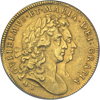 |
Great Britain. 2 Guineas, 1694/3. Fr-301; S-3424. William and Mary. Conjoined busts right. Reverse: Crowned arms. PCGS graded AU-53.
Estimated Value $4,000 - 5,000.
Not part of the Terner Collection.
View details and enlarged photos
| Realized
$3,105 |
Lot 140 |
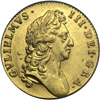 |
Great Britain. Guinea, 1695. William III, 1st laureate Bust. S-3458; Fr-313; KM-488.1. An elusive portrait type which is extremely rare in this splendid condition. PCGS graded MS-62.
Estimated Value $4,000 - 5,000.
Ex Bridgewater House Collection. One of the finest provenances possible.
View details and enlarged photos
| Realized
$7,763 |
Lot 141 |
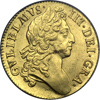 |
Great Britain. Guinea, 1698. William III, 2nd laureate Bust. S-3460; Fr-313; KM-498.1. Human-shaped harp on reverse shield. Very rare in this exalted state of preservation. A tiny tin "haymark" (impurity) on the king's cheekbone, but well struck and having gorgeous satiny luster. PCGS graded AU-58.
Estimated Value $3,000 - 4,000.
View details and enlarged photos
| Realized
$5,750 |
Lot 142 |
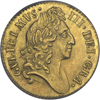 |
Great Britain. Half Guinea, 1698. William III. S-3468; Fr-315; KM-487.3. Laureate Bust combined with crowned cruciform shields having scepters in the angles with the late harp style. Rare type, coined for only 5 years; in fact, this piece is the only half guinea of William III found in 22 years of searching that was deemed appropriate for inclusion in the collection. Handsome and lustrous. PCGS graded AU-58.
Estimated Value $1,500 - 2,000.
Ex Norweb Collection.
View details and enlarged photos
| Realized
$2,415 |
Lot 143 |
 |
Great Britain. Guinea, 1700. William III, 2nd laureate Bust. S-3460; Fr-313; KM-498.1. Human-shaped harp on shield. Very rare. A few faint flan adjustments on entire obverse, but sharp and handsome with flashy luster. PCGS graded AU-58.
Estimated Value $3,000 - 4,000.
View details and enlarged photos
| Unsold |
Lot 144 |
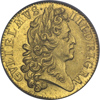 |
Great Britain. "Fine Work" Guinea, 1701. William III, 3rd laureate Bust. S-3465; Fr-313; KM-506. An extremely rare condition for this, the splendid periwig version of King William's portrait. Probably the finest known of its type. PCGS graded MS-63.
Estimated Value $4,000 - 6,000.
Ex Norweb collection, bought at the auction in 1986.
View details and enlarged photos
| Realized
$13,800 |
Lot 145 |
 |
Great Britain. Guinea, 1701. William III, 2nd laureate Bust. S-3463; Fr-313; KM-498.1. An especially choice guinea, bought in 1984 and never bettered since, despite constant searching for great coins. PCGS graded MS-62.
Estimated Value $2,500 - 3,000.
View details and enlarged photos
| Realized
$7,763 |
Lot 146 |
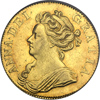 |
Great Britain. Guinea, 1702. Queen Anne. S-3562; Fr-320; KM-511.1. Pre-Union reverse style. Extremely rare as a type and also as a date in this grade: superb luster, slightly prooflike, boldly struck everywhere with dazzling eye-appeal. Quietly believed, by in-the-know dealers, to be the finest Pre-Union guinea seen in the past 50 or more years. PCGS graded AU-58.
Estimated Value $4,000 - 6,000.
View details and enlarged photos
| Realized
$11,500 |
Lot 147 |
 |
Great Britain. Guinea, 1709. Queen Anne, After Union type, 2nd Bust. S-3572; Fr-320; KM-529.1. One of only three years struck in this exact style. Rare date and grade; in fact, one of the finest ever seen, with prooflike glittering surfaces! Exceptional eye-appeal. PCGS graded AU-58.
Estimated Value $2,000 - 3,000.
View details and enlarged photos
| Realized
$7,475 |
Lot 148 |
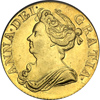 |
Great Britain. Guinea, 1710. Queen Anne, After Union type, 3rd Bust. S-3574; Fr-320; KM-534. Rare, another date almost never seen. A faint hairline scratch in the right obverse field, but well struck with bright luster, and still very choice and desirable. PCGS graded AU-58.
Estimated Value $2,000 - 3,000.
View details and enlarged photos
| Realized
$7,475 |
Lot 149 |
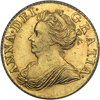 |
Great Britain. Half Guinea, 1710. Queen Anne, After Union reverse. S-3575; Fr-323; KM-527. Sharp, pleasing, and quite rare. PCGS graded AU-58.
Estimated Value $1,500 - 2,000.
View details and enlarged photos
| Realized
$2,990 |
Lot 150 |
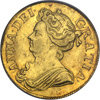 |
Great Britain. Guinea, 1712. Queen Anne, After Union type, 3rd Bust. S-3574; Fr-320; KM-534. Another seldom-seen date. Superb surfaces, sharp strike, glowing luster, old-time gold toning, and (most curiously) a slightly odd flan and denticles. A fascinating coin which reveals the technology of the day because of the shape of its flan. PCGS graded MS-62.
Estimated Value $2,500 - 3,500.
View details and enlarged photos
| Realized
$7,475 |
Lot 151 |
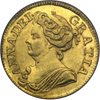 |
Great Britain. Guinea, 1713. Queen Anne, After Union type, 3rd Bust. S-3574; Fr-320; KM-534. An excellent specimen, boldly struck and very choice, with mellow old-time gold toning. PCGS graded MS-62.
Estimated Value $2,500 - 3,500.
View details and enlarged photos
| Realized
$7,475 |
Lot 152 |
 |
Great Britain. Half Guinea, 1713. Queen Anne, After Union reverse. S-3575; Fr-323; KM-527. Prooflike and particularly choice. PCGS graded MS-62.
Estimated Value $2,000 - 2,500.
Ex Norweb Collection.
View details and enlarged photos
| Realized
$4,370 |
Lot 153 |
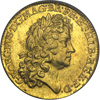 |
Great Britain. Guinea, 1714. George I, Prince Elector. 1st Bust. S-3628; Fr-538; KM-538. The distinctive and very rare 1-year type, the only such English gold coin actually noting in full the king's German origins, for George was, first and foremost, Prince Elector of Hanover, for the Holy Roman Empire. The end of the reverse legend denotes this, with the distinctive "PR EL" among the king's titles. Evidently the use of the extra "PR" was determined as crowding the legend, and it was not used on other coinages. A superb and boldly struck example, one of the finest known. PCGS graded MS-63.
Estimated Value $5,000 - 7,000.
Ex Bridgewater House Collection. The finest possible provenance. Purchased in 1984.
View details and enlarged photos
| Realized
$15,525 |
Lot 154 |
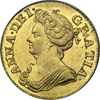 |
Great Britain. Guinea, 1714. Queen Anne, After Union type, 3rd Bust. S-3574; Fr-320; KM-534. The final date of issue for this monarch. The only "common" date, but most are not so fine as this beautiful coin. PCGS graded AU-58.
Estimated Value $2,000 - 2,500.
View details and enlarged photos
| Realized
$2,875 |
Lot 155 |
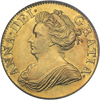 |
Great Britain. Half Guinea, 1714. Queen Anne, After Union reverse. S-3575; Fr-323; KM-527. Last year of issue. Another piece of rare grade, with superb eye-appeal, a bold strike, and brilliant satiny luster. Lightly clashed dies. PCGS graded AU-58.
Estimated Value $2,000 - 2,500.
View details and enlarged photos
| Unsold |
Lot 156 |
 |
Great Britain. Guinea, 1715. George I, 3rd Bust. S-3630; Fr-327; KM-543. Each of the dates made in the early history of the Hanoverian kings is rare. The 3rd Bust was used in only two years, 1715 and 1716. This lustrous, pleasing coin was purchased in 1988, and never bettered. PCGS graded AU-58.
Estimated Value $2,500 - 3,000.
View details and enlarged photos
| Realized
$3,335 |
Lot 157 |
 |
Great Britain. Half Guinea, 1717. George I, 1st Bust. S-3635; Fr-329; KM-541.1. Rare type! Lustrous with a nice sharp strike, and a large diebreak on the king's face. Glittering eye-appeal. Missing from the Douglas-Morris Collection; evidently a very rare grade for the first of the House of Hanover small gold. PCGS graded AU-58.
Estimated Value $2,000 - 3,000.
View details and enlarged photos
| Unsold |
Lot 158 |
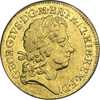 |
Great Britain. Guinea, 1719. George I, 4th Bust. S-3631; Fr-327; KM-546.1. Elusive! A choice piece with very slight doubling of strike (so very common to this era). PCGS graded AU-58.
Estimated Value $2,000 - 3,000.
View details and enlarged photos
| Realized
$3,335 |
Lot 159 |
 |
Great Britain. Guinea, 1720. George I, 4th Bust. S-3631; Fr-327; KM-546.1. A delightful specimen, boldly struck, perfectly centered, and highly lustrous. Exceptional eye-appeal. PCGS graded MS-62.
Estimated Value $4,000 - 5,000.
Ex Douglas-Morris.
View details and enlarged photos
| Realized
$12,075 |
Lot 160 |
 |
Great Britain. Guinea, 1723. George I, 5th Bust. S-3633; Fr-327; KM-559.1. The final portrait. Pleasing and lustrous, and evidently very rare, for it was one of only two guineas in the collection we ever thought of improving upon, but a better one never appeared since it was purchased in 1984. PCGS graded AU-58.
Estimated Value $2,000 - 2,500.
View details and enlarged photos
| Realized
$3,335 |
|
|